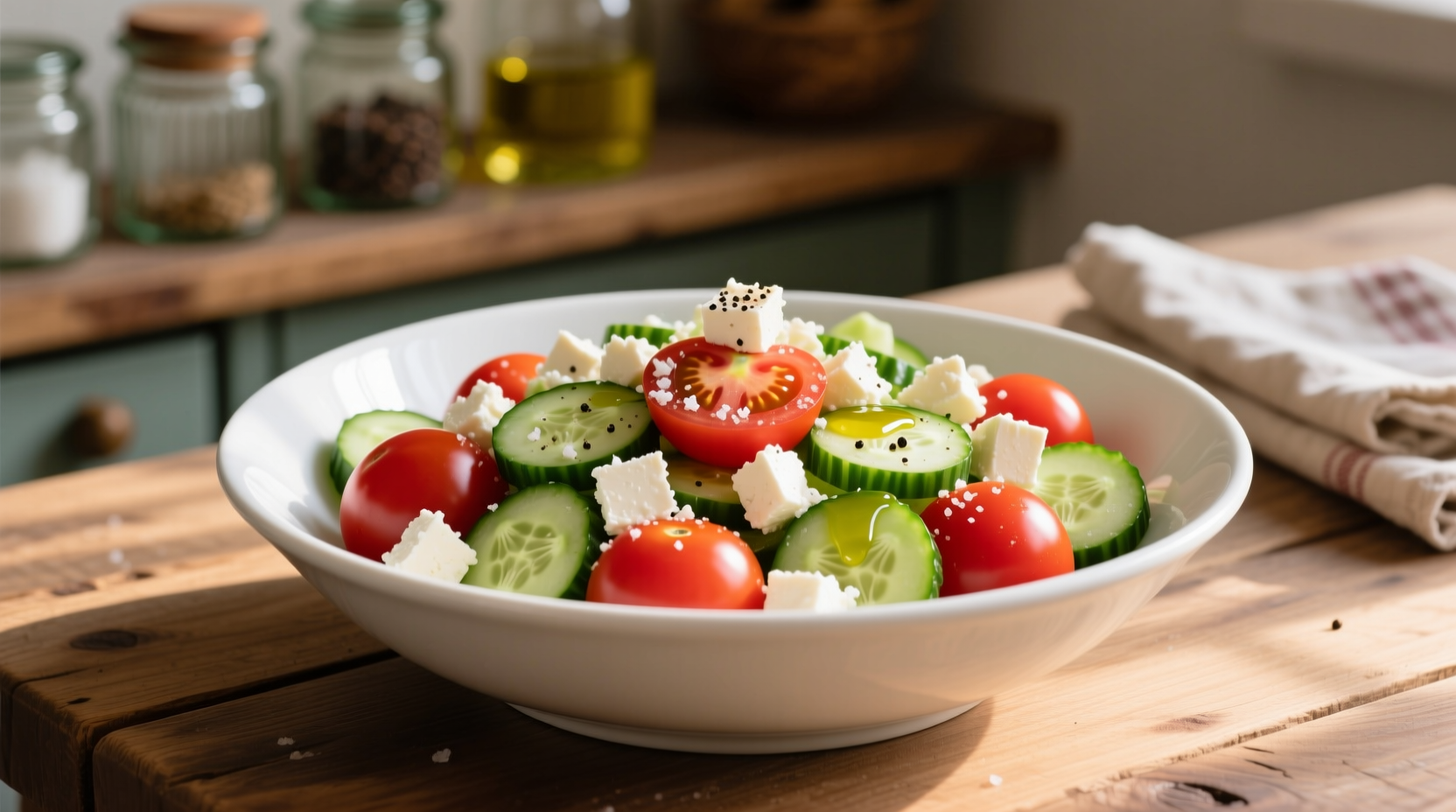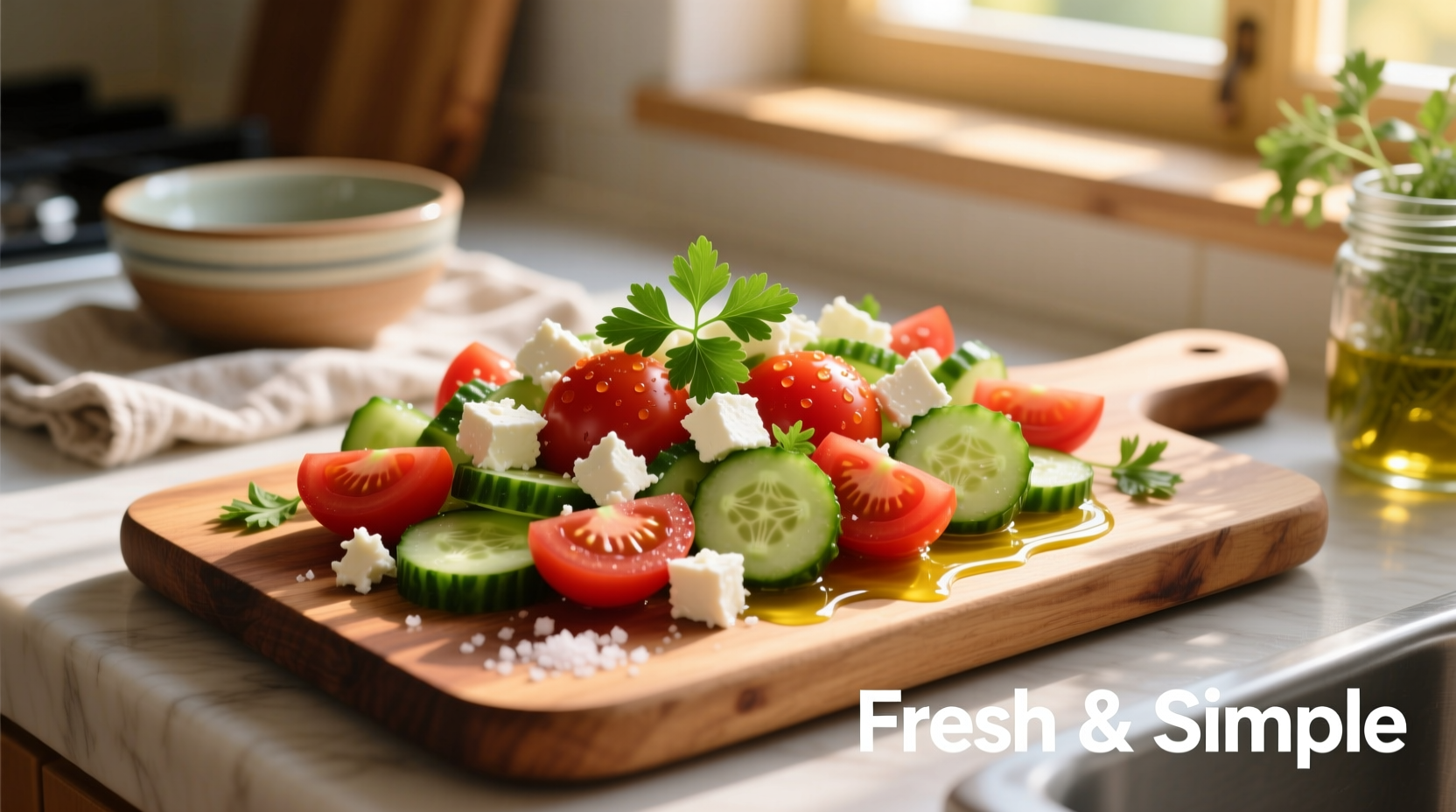When summer's bounty arrives, nothing satisfies like a crisp tomato and cucumber salad with feta. This authentic Mediterranean preparation balances sweet vine-ripened tomatoes, cool English cucumbers, and tangy feta cheese with a lemon-herb dressing that enhances rather than overwhelms. Unlike traditional Greek salad, this version skips lettuce for a more substantial vegetable-forward dish perfect alongside grilled meats or as a standalone light meal.
Why This Tomato Cucumber Feta Salad Works
The magic happens through careful ingredient selection and proper technique. According to culinary science research from the USDA Food Data Central, tomatoes and cucumbers contain complementary flavor compounds that intensify when combined. The salt in feta cheese draws out moisture from the vegetables, creating a natural dressing while maintaining crisp texture when prepared correctly.

Selecting Premium Ingredients
Quality determines success in this simple recipe. Choose these specific varieties for best results:
- Tomatoes: Heirloom varieties like Brandywine or Cherokee Purple for complex sweetness
- Cucumbers: English or Persian cucumbers (fewer seeds, thinner skin)
- Feta: Authentic Greek feta in brine (sheep or goat milk, not cow)
- Herbs: Fresh dill and mint (dried won't provide same brightness)
| Nutrient | Per Serving | Daily Value |
|---|---|---|
| Calories | 185 | 9% |
| Protein | 7g | 14% |
| Vitamin C | 25mg | 28% |
| Calcium | 150mg | 12% |
Nutritional data based on USDA FoodData Central analysis of standard recipe portions
Step-by-Step Preparation Guide
Follow these professional chef techniques for perfect results every time:
- Prep vegetables properly: Cut tomatoes into 1-inch chunks, cucumbers into half-moons. Never dice small - larger pieces maintain texture.
- Salt tomatoes first: Sprinkle tomatoes with ¼ tsp salt and let drain in colander for 5 minutes. This prevents watery salad.
- Handle feta carefully: Crumble by hand rather than slicing for better texture distribution.
- Dress at right moment: Combine dressing ingredients, then toss with vegetables just before serving (max 10 minutes ahead).
Avoid These Common Mistakes
Based on FDA food safety guidelines, improper handling causes most salad failures:
- Using refrigerated tomatoes: Cold temperatures destroy flavor compounds. Store tomatoes at room temperature until cut.
- Adding feta too early: Salt in feta draws moisture from vegetables, making salad soggy if added more than 10 minutes before serving.
- Over-dressing: Start with half the dressing, adding more only if needed. The salad should glisten but not pool liquid.
- Using pre-cut vegetables: According to FDA fresh-cut produce guidelines, pre-cut vegetables lose nutrients faster and risk contamination.
Variations for Different Dietary Needs
This versatile base recipe adapts beautifully:
- Vegan version: Substitute feta with almond-based cheese or omit entirely, adding 2 tbsp capers for salty tang
- Lower sodium: Use reduced-salt feta and increase lemon juice to compensate for flavor
- Extra protein: Add ½ cup chickpeas or grilled shrimp for complete meal
- Seasonal twist: In winter, add roasted bell peppers and swap fresh dill for dried oregano
Serving and Storage Recommendations
For optimal freshness and food safety:
- Chill serving bowls for 15 minutes before plating
- Pair with grilled chicken, fish, or crusty bread for complete meal
- Consume within 2 hours at room temperature per FDA food safety standards
- Store leftovers in airtight container for up to 24 hours (flavor improves slightly)
- Never freeze - vegetables become mushy upon thawing
Frequently Asked Questions
Can I make this salad ahead of time? Yes, but keep components separate. Store cut vegetables in one container, dressing in another, and feta crumbled in a third. Combine no more than 10 minutes before serving for perfect texture.
What's the best olive oil for this salad? Choose a medium-intensity extra virgin olive oil from Greece or California. Avoid robust oils that overpower delicate vegetable flavors. Test by drizzling on bread - it should taste fruity, not bitter.
Why does my salad get watery? Two common causes: tomatoes weren't salted to draw out excess moisture, or vegetables were cut too small. Larger vegetable pieces maintain structure better. English cucumbers also contain less water than standard varieties.











 浙公网安备
33010002000092号
浙公网安备
33010002000092号 浙B2-20120091-4
浙B2-20120091-4